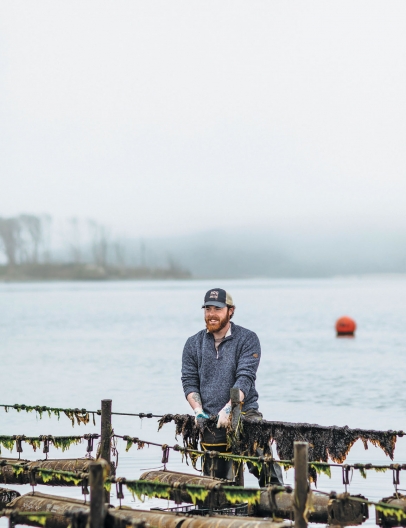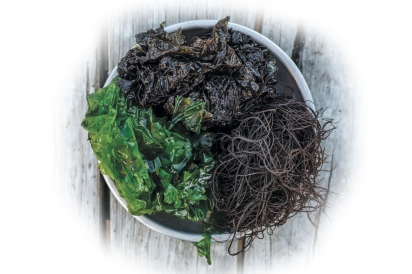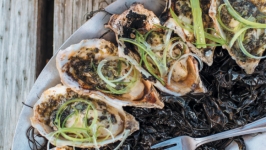Greens from the Sea
Who fancies their grilled oysters bathed in a briny nori compound butter? Or what about a salmon poke bowl with strands of fresh, crunchy ogo adding ocean notes? Or how about elevating a Bloody Mary with fried dulse, a red seaweed with a flavor reminiscent of bacon?
The culinary and cocktail crew at Hog Island Oyster Co. are clearly having fun playing with the seaweeds that grow naturally alongside their signature Sweetwater oysters, but which have until recently been off limits for commercial use. The seaweeds in question: nori (genus Pryopia), ogo (Gracilaria), dulse (Palmaria) and ulva (Ulva, an abundant, bright green alga commonly known as sea lettuce).
For 40 years, Hog Island Oyster Co. has harvested oysters and Manila clams to serve at their farm in Marshall, in their restaurants in Marin, Napa and San Francisco and via wholesale accounts at Bay Area fine-dining spots, which include Single Thread in Healdsburg; Farmstead in St. Helena; Saltwater in Inverness; and Zuni Cafe, State Bird Provisions, The Progress, Anchovy Bar, Foreign Cinema, Octavia and Frances in San Francisco.
As part of their shellfish farming practices, harvesting has always included a steady diet of seaweed as a kind of bycatch. Pull the reusable mesh bags laden with oysters out of the water and they’re covered in glistening ribbons of the salty, slimy stuff. Typically, the mounds of seaweed clinging to farm equipment, including the oyster baskets and the stakes to which they are attached, would simply be periodically removed, left to dry on land and then composted on the ranch across the road.
But where some see a pile of leftover detritus shriveling in the sun, others see an opportunity. The Hog Island team has always looked to the water for inspiration, innovation, sustenance and environmental stewardship. There’s a reason chef Hugh Acheson calls one of the country’s leading seafood producers “a superhero for sustainable aquaculture.” They see seaweed as another ocean offering that could be put to excellent use on land—including on the table.
It didn’t take these oyster farmers, led by founding partners John Finger and Terry Sawyer, four decades to figure out seaweed is delicious, nutritious and deserves a place on the menu. Boat crews snack on fresh ogo while working, notes Hog Island’s quality assurance manager Max Rintoul. But because Pacific herring are known to spawn in Tomales Bay, using seaweed to settle their eggs, collecting it for commercial use was a no-go.
Until recently. In June 2022, Hog Island received approval for an amendment to its shellfish lease from the California Fish and Game Commission that allows the business to harvest and sell four different seaweeds that grow on their farm gear, according to Gary Fleener, Hog Island’s science, sustainability and farm education manager. As far as they know, Fleener says, Hog Island is the first California company to be regulated for seaweed harvesting associated with shellfish aquaculture.
Hog Island is now approved for seaweed harvesting between March 1 and October 31 each year, which is outside the time span when Pacific herring spawn on marine macroalgae (aka seaweed) in the Bay, to ensure that vulnerable roe aren’t disturbed during seaweed removal. “We’re an ocean-to-table farming business and we like the idea of diversifying what we produce if the ocean provides other opportunities,” says Fleener, who is a fan of pickled ogo, among other seaweed bites.
“This is something that Hog Island is kind of good at. We’re established. We’re big enough,” says Fleener of a company that pre-pandemic sold 5 million oysters and clams a year and had a staff of around 300 employees. “I suspect that in the next few years, if we can demonstrate there’s economic value in doing this, every oyster farm in California will file for the same amendment to its lease.”
As for seaweed’s standing on the menu at Hog Island, he says: “We’re really looking to move it from the margins of our culinary program closer to the middle, to stand alongside other ocean foods like shellfish.”
A taste of place: from the tide to the table
That’s where the culinary team takes over. Lauren Kiino, Hog Island’s new culinary director, is familiar with working with seaweed from her days in the kitchens at trailblazing restaurants like San Francisco’s Coi, now closed, where she recalls fresh seaweed accompanying abalone, in a salad and as a pasta filling. Kiino, who has staged in some of the Bay Area’s most acclaimed restaurants, including The French Laundry, Boulette’s Larder and Rubicon, served as chef de cuisine at San Francisco’s Delfina for eight years before running her own restaurants in the city for a dozen years, including Il Cane Rosso in the Ferry Building. The Marin resident comes to Hog Island after several years as a private chef.
She describes nori, the dark-green dried seaweed, as a workhorse and the most versatile seaweed Hog Island has to experiment with. “It’s super savory,” she says. “It adds an ocean vibe” to anything it’s paired with. “Seaweed has the ability to bring every ingredient together in an umami bomb.” She’s curious about its potential in everything from chips and dips, crudo and condiments to fish and furikake, salads and soups and as a topping for granola or popcorn. Commercial-grade dehydrators at the company’s commissary kitchen in Petaluma allow Hog Island to process seaweed in-house.
Back on the farm, the Hog Island team likes to talk about how their food imparts a taste of place. There’s a word for it: merroir— a newish term coined from the French word for sea (mer) and the term terroir (soil/land), which refers to the unique taste of place of an agricultural product grown in a specific area. Terroir is often referenced when describing wine. Oysters, of course, have their own merroir. So it makes sense that seaweed does, too.
The time of year the seaweed is harvested can impact flavor, as well. So can both the salinity of the water and the depth at which it has grown (relatively close to the surface versus deep down in oftentimes muddy and murky conditions). Hog Island intends for the best seaweed it harvests (in terms of appearance and flavor) to go to culinary uses.
Once harvested, the farm will hold some of the seaweed in tumbling tanks to help keep it fresh and extend its shelf life, explains Rintoul. Nori is most often eaten dried and toasted, while ogo is typically eaten fresh. It’s early days in this project with lots of the specifics still being worked out. For instance, there’s loads of sea lettuce to consider, but it’s less exciting to the team than nori or dulse, which are not as prolific here. As its name implies, sea lettuce is pleasant enough but kind of bland and relies on other ingredients to boost its profile.
On the libation side of the equation, Hog Island’s cocktail and spirits manager Saul Ranella gets excited talking about how seaweed can lift a cocktail program’s game. He’s experimented with using it fresh, fried, dehydrated, smoked and pickled. Dried seaweed introduces umami flavors into a cocktail that slowly infuse the drink as it rehydrates, Ranella says. Adding pickled ogo to the mixed drink known as a Tom Collins adds a pop of sea color, while also providing a fun nibble while you imbibe.
At Hog Island’s San Francisco Ferry Building restaurant, diners can already order the Merroir Martini, which delivers that sense of place—the scent and taste of the sea—by pairing Bay Area–based Grey Whale gin [See the distiller’s profile in our Winter 2022 issue], aperitif and vermouth with foraged nori, fresh lemon oil and a smoked roe garnish—served with a Sweetwater oyster. Cheers to that and down the hatch! Expect more seaweed—this time straight from the farm—popping up on the drinks menu in the days ahead.
In Hog Island’s latest cookbook, seaweed also earns a nod. The Hog Island Book of Fish and Seafood was written by longtime Hog Island friend and board member John Ash, a James Beard Award–winning cookbook author, chef and restaurateur. Seaweed shines in a chapter dubbed “Other Gifts From the Sea.” Recipes feature nori, kombu, wakame and dulse, known for its soft, leathery texture. Find Cabbage Salad Tossed with Shio Kombu; Miso Soup with Tofu and Wakame; a DLTA (that’s Dulse, Lettuce, Tomato and Avocado Sandwich); and Seaweed Chips made from dried nori sheets and whole-leaf dulse.
Harvesting volunteer seaweed sits solidly within Hog Island’s conservation goals of contributing to climate resiliency and limiting waste. It’s a relatively easy product to harvest with low overhead: Seaweed doesn’t require any special food or freshwater to grow. And there’s no additional labor involved, since crew members are already pulling the seaweed off their gear anyway.
Climate changes continue to have an impact on the oyster farm. Earlier this year a series of so-called atmospheric rivers forced multiple closures on the farm. Torrential rain and storms happen most winters, but this year has been a particularly long winter storm season. Shutdowns, which might typically last a few days, have gone on for weeks. There were about 22 oyster harvest days in the first quarter of 2023, with somewhere between 60 and 90 closures days. The closures are costly and inconvenient, but necessary: Each time it rains a half-inch or more the farm is required to pause harvest and must test for fecal coliform bacteria carried down from neighboring ranches in storm runoff. The bacteria levels are closely monitored by the California Department of Public Health.
At time of writing, the company was having its seaweed tested, too, including for any toxic trace metals or bacterial pathogens.
They are doing this even though seaweed is not a filter-feeding organism like an oyster and there are currently no regulatory standards for harvested seaweed in California, according to Fleener, who expects that will evolve over time in this nascent field. It’s just the right thing to do, in keeping with company ethos, he says.
The company has looked to existing expertise on this subject on the East Coast. Hog Island has adopted best practices in production and processing seaweed developed by Connecticut Sea Grant in partnership with the Connecticut Department of Agriculture Bureau of Aquaculture, which offers a comprehensive guide to possible food safety hazards associated with seaweed. The state is considered a leader in the field, in part because it’s home to GreenWave, a nonprofit launched by former fisher Bren Smith, who had become disillusioned with the damage inflicted by commercial fishing on the planet’s oceans. Smith established GreenWave to catalyze the regenerative ocean farming movement and offer training and tools to ocean farmers eager to integrate environmentally friendly and climate-change-resistant practices.
Seaweed’s moment in the sun
Seaweed, of course, has been a staple of many cultures’ cuisines for centuries in Asia and Europe, whether foraged in the wild or farmed for commercial purposes. In the United States, nori is probably the best-known seaweed for culinary use—think sushi rolls, seaweed snacks and furikake sprinkles. Nori is a red seaweed that turns a very dark green—sometimes almost black— when dried and toasted. It’s sold in coarsely textured sheets that give hints of salty minerality. But there are thousands of seaweed species, most of them edible, and a handful of other varieties are increasingly finding their way into the kitchens of both home cooks and professional chefs.
In the U.S., seaweed has long played a role in the diet of Asian Americans and Indigenous coastal communities, natural- and foraged-food enthusiasts and culinary adventurers. Now it is becoming increasingly mainstream.
As the New York Times noted in March, seaweed is definitely having a moment in the sun. And not just in the kitchen: It’s also used in toothpaste and cosmetic products. And, in a warming world, seaweed has become a hot global commodity.
In California, Hawaii and Australia, the red seaweed known as Asparagopsis is being cultivated as cattle feed, since studies have shown it can cut methane gas from cow burps. That matters, since cattle belches are a major source of methane, a big problem in the war against potent greenhouse gases heating up the globe. [See our Spring 2022 story on this subject and its local relevance in “Red Seaweed & Green Cows.”] In London, a start-up called NotPla is creating packaging that uses brown seaweed as a plastic substitute.
Hog Island is also considering other uses for its bounty of seaweed. There are potentially many tons of seaweed that could be harvested, but the culinary demand thus far is measured in mere pounds. In addition to compost for soil, other applications are currently in the exploratory phase.
Meanwhile, watch for it to find its way onto Hog Island’s restaurant menus and, down the track, perhaps via shelf-stable packaged pantry products sold in their online store. “There’s a lot of room for innovation, creativity and learning,” says Fleener. “And we’re really well-positioned to help tell that seaweed story at the front line. We serve a half million people a year, we have a lot of visibility. We also need to do it right. So we’re taking it slow, but we’re super excited to have this opportunity with seaweed. And if we come up with some cool stuff, that’s great too.”









